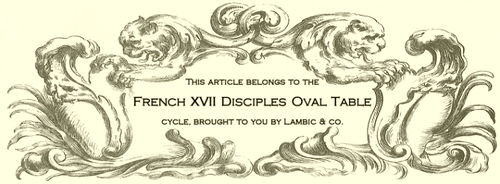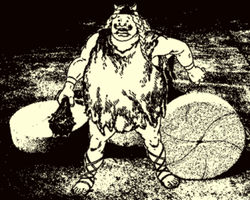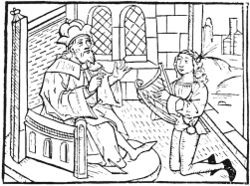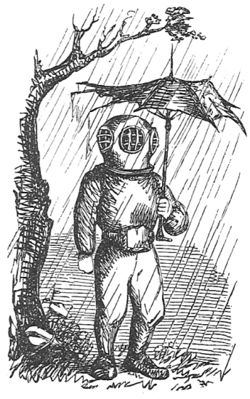Albert Nonyme
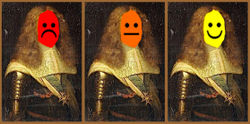
“Blast the Nonymous family: much of my most poignant remarks have been attributed to them!”
– Oscar Wilde in "Genealogy: you have to like it"
“It is not because a Chinese saying is old, that it is therefore Chinese!”
– Old Chinese saying, attributed to An On Ymus, from the Chinese Branch
Albert Nonyme (born 1642 in Perpignan (France), died 1710 in Paris (France)) can be considered France's most lucky and most ambitious genealogist. It was he who started researching the main branches of a large and creative dynasty, a research that was to result, centuries later, in decent copyright and royalties laws.
A good reason for research: money![edit | edit source]
Yes, money was Albert's main motive for researching the Nonyme Dynasty. He wanted to lobby for a law concerning "royalties", and tried to convince Louis XIV of passing such law. There was some logic in this: the word "royalties" would certainly charm the pretty self-conscious monarch, who worked very hard to establish the "L'état, c'est moi!" ("The state, that's me!" in foreign manuals) idea his private teacher Louis Casserole once made him conjugate in all tenses.
Highlights from the longest dynasty evah![edit | edit source]
The Nonymes already had a very long genealogical tradition. But for some reason only dates and places of birth and death had been recorded, no activity whatsoever. The family tree goes way back to one Aurelius Nonymus, a veteran from Augustus' Egyptian campaign, who settled in "Colonia Nemausa", now Nîmes (France) round 25 BC. In 1066 AC, Alfred Nonymus, soldier of William the Conqueror, took the name to England, where it became "Nonymous" round 1234 AC. About that time, the members of the French Branch started to call themselves "Nonyme". The Nonyme Dynasty is probably the longest dynasty in history, even longer than the Thong Dynasty, although we will only be able to tell for sure when Professor W. Booty will have finished her research
The Roman ancestors (60 BC - 476 AC)[edit | edit source]
- Aurelius Nonymus. Born 60 BC in Rome (Italy), died 5 BC in Colonia Nemausa (France). First documented member of the family. Artistic activity unknown. Claimed that one of his ancestors, Arrr Nonim, invented the wheel, but had no written proof to support that claim. He once made a silly drawing of what he thought that ancestor looked like. The drawing has been in the Nonymus/Nonyme family ever since.
- Amadeus Nonymus. Born 1 BC in Colonia Nemausa (France), died 60 AC ib. Architect. Designed the local "Pont du Gard" aqueduct round 45 AC.
- Antonius Nonymus. Born 4 AC in Colonia Nemausa (France), died 70 AC ib. Painter. Brother of Amadeus. Made a painting of the Pont du Gard during the summer of 50 AC, when the left half of it was missing. It had been borrowed by Spain-based Roman builders who wanted to construct a similar one in Segovia (Spain), and needed an example. They were on scheme, and brought it back before fall.
The Common Branch (476 - 1066)[edit | edit source]
- Arnulfus Nonymus. Born 748 in Reims (France), died 814 ib. Poet and biased journalist. Sole survivor of the "Battle of Roncevaux Pass" (778). Hidden behind a well furnished Bush, he witnessed the tragical death of Hruodland ("Roland" in foreign manuals), and simultaneaously he wrote a poem-article about it. He wrote it in verse, so it could be transmitted (sung, actually) easier. He didn't write it in Latin, as would have been usual for a chronicler back then, but in "romana lingua", ancestor of Medieval French. Arnulfus substituted "Moors" for the actual Basque assaulters of Roland, because that fitted in the anti-Moor publicity campaign of Charlemagne, King of France, and Silo, King of Asturias (Spain). He made at once two copies: one went south, to Asturias, eventually inspiring the "Cantar de mio Cid" at the end of the XIIth Century; the other went north, to France, eventually inspiring the "Chanson de Roland" at the end of the XIst Century. The Moors kept their position of bad guys. Arnulfus' poem-article was regularly performed in front of the troops (Spanish and French) when preparing for an important battle, like that of Hastings, by a singer who improvised a psalmodic kind of melody for the text. French and Spanish linguists are still hoping that a copy of Arnulfus' report will show up: it would become the oldest text in Romance language. Albert Nonyme probably owned such copy, or at least a fragment of it. Further investigation of the Disciples' documents will tell more. Some day...
The French Branch (1066 - 1710)[edit | edit source]
Due to the confusion the family created by giving their offspring only names beginning with "A", Albert Nonyme found it necessary to split them in Male and Female creators.
Male French creators[edit | edit source]
- Alphonse Nonymus. Born 1048 in Cherbourg (France), died 1108 in Couille-la-Grande (France). Twin brother of Alfred. Designed and embroided the second half of the first comic strip in history, known as the Bayeux Tapestry (1067). Founding Father of the French Branch.
- Adam Nonymus. Born 1190 in Avignon (France), died 1228 ib. Architect. Designed the famous "Pont d'Avignon" in 1227, to replace the one King Louis VIII destroyed during the 1226 siege. When asked why he spent ten year of the city's tax income building a bridge that didn't go further than the middle of the stream, he pretended he'd been inspired by an Ancient Roman wall painting. He was executed shortly after.
- Adrien Nonyme. Born 1214 in Avignon (France), died 1260 ib. Songwriter. Son of the architect Adam. Wrote the song "Sur le Pont d'Avignon" in 1228, shortly after his father's execution. Then he moved to Eaubonne (France), where he changed his name from the original Latin "Nonymus" into the more French sounding "Nonyme" in 1234, shortly before the birth of his first child, Adrienne.
- André Nonyme. Born 1620 in Perpignan (France), died 1670 ib. Songwriter. Father of our Albert. André wrote the "Frère Jacques" canon, as well as "Au clair de la lune" (often erroneously attributed to Jean-Baptiste Lully) and "Ah! vous dirai-je maman?" ("Twinkle, twinkle, little star" in foreign manuals).
Female French creators[edit | edit source]
- Adrienne Nonyme. Born 1234 in Eaubonne (France), died 1302 in Kortrijk (Flanders). Inventress. Daughter of the songwriter Adrien. First descendant to be born as a "Nonyme". Developed the "scaphandre" ("clumsy diving suit" in foreign manuals and the "parapluie" ("umbrella" in foreign manuals). The umbrella was meant to protect from rain while above water, the scaphandre was meant to protect from rain while under water. The latter was the least successful. Since the design was actually derived from that of a regular armour, she tried to use it as such during the "Battle of the Golden Spurs" in Flanders (1302). It didn't work.
The English Branch (1066 - 1710)[edit | edit source]
Male English creators[edit | edit source]
- Alfred Nonymus. Born 1048 in Cherbourg (France), died 1108 in Little Bollocks (England). Twin brother of Alphonse. Came to England with the army of William the Conqueror. Designed and embroided the first half of the first comic strip in history, known as the Bayeux Tapestry (1067). Founding Father of the English Branch.
- Anonymousia de Bergerac-Fleur. Born 1094 in Little Bollocks (England), died 1332 in Cleveland (US-to-be). See the outstanding article Professor Portzebie and his staff wrote about this curious member of the Dynasty. This was the very first one add the "o" to the "u" in the original Latin name (round 1234).
- Andrew Nonymous. Born 1585 in Stratford-upon-Avon (England), died 1651 in London (England). Songwriter. Wrote "Tavern in the town", dedicated to his beloved pub "The Nag's Head", and "The foggy, foggy dew", the latter title giving an idea of how Andrew saw the landscape on his way home after a jolly evening in said pub. During hist last days, which he spent in London, he wrote his only "custom made" song, for an Irishman returning to Dublin after a long stay in London. The song was called "Molly Malone", and was inspired by sailors' tales he had heard about fantastic molluscs.
Female English creators[edit | edit source]
- Anna Nonymous. Born 1507 in Blickling (England), died 1536 in London (England). Songwriter. Wrote "Greensleeves" (often erroneously attributed to King Henry VIII), inspired by her newly bought green longsleeved gown, and "Old MacDonald", dedicated to her much older husband.
Molière's seat at the Oval Table[edit | edit source]
Molière having died in February of 1673, Nonyme was presented the seat of the deceased, which he gladly accepted. He was even more pleased when told that he didn't have to take the heavy piece of furniture all the way home, but that he could leave it, and sit in it from the 3rd till the 4th Friday of January, starting in 1674.
The research continues[edit | edit source]
Although no serious "royalties" law came before "royalty" itself had become a pure society conversation piece, and no copyright or royalties law ever entitled this family to the wealth they dreamed of, Albert's descendants keep the research going. Turkmenistan seems to be willing to do something for them, but then the'll have to take the Turkmen nationality, and pay a 75% tax on the royalties.
